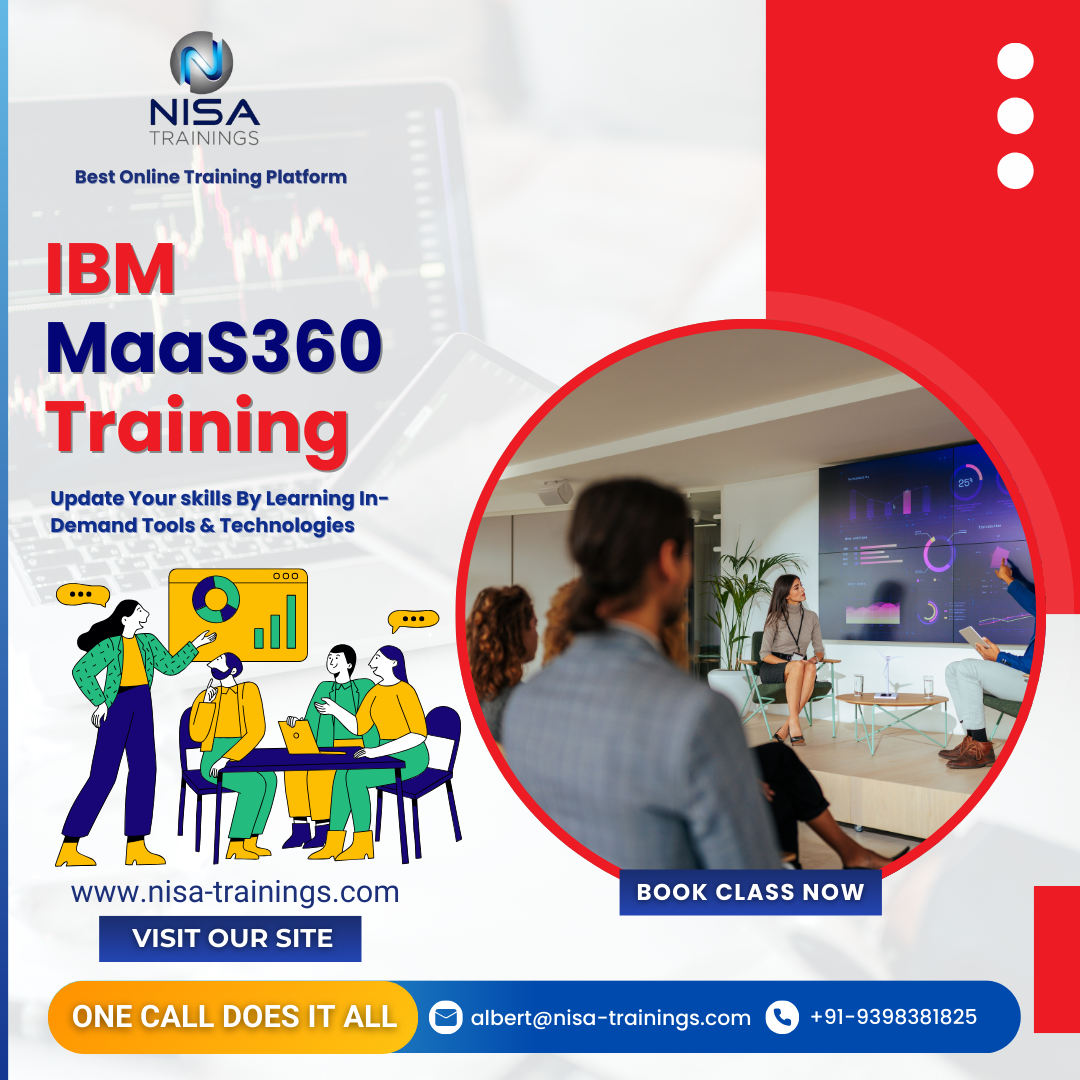IBM MaaS360 Training
Categories
IBM Courses
Course level:Intermediate
IBM MaaS360 is a comprehensive mobile device management (MDM) and unified endpoint management (UEM) platform. It helps businesses manage and secure a wide range of mobile devices, apps, and content in a corporate environment.

Why should you choose Nisa For IBM MaaS360 Training?
Nisa Trainings is the best online training platform for conducting one-on-one interactive live sessions with a 1:1 student-teacher ratio. You can gain hands-on experience by working on near-real-time projects under the guidance of our experienced faculty. We support you even after the completion of the course and happy to clarify your doubts anytime. Our teaching style at Nisa Trainings is entirely hands-on. You’ll have access to our desktop screen and will be actively conducting hands-on labs on your desktop.
Job Assistance
If you face any problem while working on IBM MaaS360 Course, then Nisa Trainings is simply a Call/Text/Email away to assist you. We offer Online Job Support for professionals to assist them and to solve their problems in real-time.
The Process we follow for our Online Job Support Service:
- We receive your inquiry for Online Job
- We will arrange a telephone call with our consultant to grasp your complete requirement and the tools you’re
- If our consultant is 100% confident in taking up your requirement and when you are also comfortable with our consultant, we will only agree to provide service. And then you have to make the payment to get the service from
- We will fix the timing for Online Job Support as mutually agreed by you and our consultant.
Course Information
IBM MaaS360 Training
Duration: 25 Hours
Timings: Weekdays (1-2 Hours per day) [OR] Weekends (2-3 Hours per day)
Training Method: Instructor Led Online One-on-One Live Interactive
Sessions.
COURSE CONTENT :
1. Introduction to IBM MaaS360
- Overview of MaaS360: Understanding the basic concepts of IBM MaaS360, its capabilities, and how it fits into enterprise mobility and endpoint management.
- MaaS360 Architecture: Explaining the architecture, components, and how MaaS360 integrates with other IBM security solutions.
- Key Features: Overview of device management, application management, security policies, and reporting capabilities.
2. Device Enrollment and Management
- Device Enrollment Options: Configuring different enrollment methods (e.g., Apple DEP, Android Zero Touch, Samsung Knox).
- Device Profiles: Creating and applying device profiles, including user profiles, configuration profiles, and security policies.
- Managing Multiple Platforms: Managing Android, iOS, Windows, macOS, and Chromebook devices from a single console.
- Device Compliance: Setting up compliance rules, checking device status, and enforcing security standards for enrolled devices.
- Containerization: Setting up a secure container to separate corporate data from personal data on mobile devices.
3. App Management
- App Enrollment: Adding, deploying, and updating apps on managed devices.
- App Security: Setting policies for app usage, including restrictions, app whitelisting/blacklisting, and app wrapping.
- App Distribution: Distributing enterprise apps and third-party apps securely through the MaaS360 platform.
- Managed Google Play and App Store: Integrating with app stores for managing apps on Android and iOS devices.
- Enterprise App Stores: Setting up an enterprise app store for internal app distribution.
4. Security and Compliance
- Setting Security Policies: Defining and enforcing security policies on devices, including password policies, encryption settings, and remote wipe.
- Threat Management: Configuring threat detection and response to security events on mobile devices.
- Data Loss Prevention (DLP): Implementing data security policies to prevent unauthorized sharing and access to corporate data.
- Geofencing and Location-based Policies: Setting up geofencing for location-based security and compliance enforcement.
- VPN and Email Management: Configuring VPN profiles and securing email on mobile devices.
5. Content Management
- Content Access Policies: Managing and controlling access to corporate content on mobile devices.
- Securing Corporate Files: Using MaaS360’s file storage and secure sharing tools.
- Document Management: Enforcing secure document handling, including editing, sharing, and syncing corporate content.
- Cloud Integration: Configuring cloud services like Box, OneDrive, Google Drive, etc., within MaaS360 for content sharing and management.
6. Advanced Device and App Management Features
- Advanced Configuration Options: Exploring advanced settings for different types of devices, like kiosk mode, corporate-owned device policies, etc.
- Mobile Threat Defense (MTD): Integration with IBM’s mobile threat defense to provide protection against advanced threats.
- Enterprise Mobility and BYOD (Bring Your Own Device): Managing a mix of corporate and personal devices with varying levels of access and security policies.
7. Monitoring, Reporting, and Analytics
- Device and App Reporting: Creating and analyzing reports to monitor device compliance, app usage, and security incidents.
- Alerts and Notifications: Setting up custom notifications to alert administrators of security breaches, non-compliance, or other issues.
- MaaS360 Dashboards: Using MaaS360 dashboards for real-time monitoring of devices, apps, and security events.
8. Troubleshooting and Support
- Device Troubleshooting: Resolving common device enrollment, compliance, and security issues.
- App Deployment Issues: Handling issues related to app distribution and installation.
- Console and System Monitoring: Monitoring the MaaS360 console for performance issues and system health.
- User Support: Managing user access and support requests, including remote wipe, device reset, and password recovery.
9. MaaS360 Integrations and Extensibility
- Third-party Integrations: Connecting MaaS360 with third-party applications, systems, and tools (e.g., Microsoft Intune, Citrix).
- Custom APIs: Using APIs to integrate MaaS360 with custom enterprise solutions.
- Automation: Configuring automation for device management, app deployment, and security policy enforcement.
10. Best Practices and Case Studies
- Implementing Best Practices: Understanding industry best practices for mobile device management and security.
- Case Studies: Real-world examples of MaaS360 deployments in various industries, highlighting lessons learned and successful implementations.
